Recruiting talented Gen Y employees is high on every organization’s priority list. Millennials will lead organizations into the future, and competition for the best talent is fierce. One way to attract high performers: Understand what they’re really looking for.
For example, Millennials value learning and development more than any other generation. So, starting with the job description, demonstrate that millennials have opportunities for growth, mentoring and development at your organization.
These articles offer more advice on recruiting top millennial talent and keeping Gen Y employees engaged once they’re on board.
Recruiting Top Millennial Talent: Marriott’s Secret Weapon. Business 2 Community: “Marriott’s Voyage program has set the bar not only within the hospitality industry but for all organizations trying to recruit and retain top entry-level talent. Aside from the results – which include a strong pipeline of highly-trained entry-level leadership and a consistent global experience – what makes Voyage so exciting is that it involved a complete redesign of the onboarding experience to match exactly what recruits were looking for. Marriott Voyage was created to supplant the company’s older, paper-based system, which wasn’t cutting it in an extremely competitive war for talent. The old system simply didn’t have the scale or opportunity for interaction that are essentially ‘table stakes’ in today’s recruiting environment. What’s more, the system didn’t map to how most of today’s new hires live their lives – plugged in and on the go.”
Community Involvement: How To Attract Top Millennial Talent Beyond The Job Description. Campus Recruitment 360: “Many students and grads will likely be pre-occupied with company information pertaining to the specific role and department that they’ll be applying to. Even though they’re not consciously looking for information about your company’s community efforts, it’s important to make sure they see it and remember it.
Be sure this information is accessible, and prominently shown on your company’s website. Bring these aspects up during a campus recruitment session or an interview when a candidate mentions their past volunteer roles or the causes they support. Remember: millennials think of their careers as an extension of their identities – not just a way to bring home the bacon.”
Perspectives on Meeting the Millennial Recruitment Challenge. ThinkAdvisor: “A key component of Advisor Group’s strategy is a ‘para‐planning mentorship program,’ which involves a junior advisor working with a senior counterpart over a five‐year period. ‘You’re not labeled as an advisor in your first five years. The focus is on truly developing yourself during that period by working with clients, refining your relationship ability and finding out your strengths,’ he explained. He noted that Advisor Group is working with an outside firm for help with some of the training and education. Beard also spoke about the importance of casting a wider net for applicants rather than focusing solely on accounting or finance majors. ‘One of our reps brought in a journalism major, who has been with him for four years now,’ he said. ‘He’s turned out to be quite the producer.’”
6 Millennial Recruiting Techniques You Need to Know About. Spark Hire: “Demonstrate quickly how Millennials can make a significant contribution to the job while they’re there, particularly if you can attach some level of social impact or purpose to the job. As a Millennial myself, I can speak to how this appeals to me and my fellow Millennials. We are more purpose-minded and socially aware. Millennials would prefer a job with purpose or social impact (i.e., reducing the company’s global environmental footprint) over just another job. While we absolutely want something that pays the bills, if you want to keep us there past one or two years, show how we can make a solid contribution to the job using what we know. Show how what we do can make a financial impact on the company, or a social impact on the community or another stakeholder. This adds something significant to us working that particular job — outside of just ‘getting paid for time.’”
4 Ways to Attract Top Millennial Talent. PROFITguide: “Millennials recognize that career development requires more than a one-day training program, so small businesses should move away from the one-size-fits-all career development model. The days of click-heavy computer-based training modules are gone. The appetite for traditional, classroom-based training is declining as the popularity of more innovative, interactive media formats rises. Videos, mobile apps, gamification, and online Q&As are more in-line with the changing media consumption habits of a millennial workforce. A Monster client in the telecommunications space created a ‘Collaboration House,’ where employees can create an online presence or avatar and go to different virtual rooms for training. Users can interact with other employees, discuss training programs, and ask questions in these virtual rooms.”
What are your secrets for recruiting top millennial talent? I’d love to know — please share in the comments!
Lindsey Pollak is a New York Times best-selling author and a nationally recognized millennial expert who helps employers recruit, train, manage and market to the millennial generation. Her speeches and training sessions inspire multigenerational collaboration and foster lasting organizational success. Contact Lindsey to learn how she can help your organization understand and connect with millennials.

